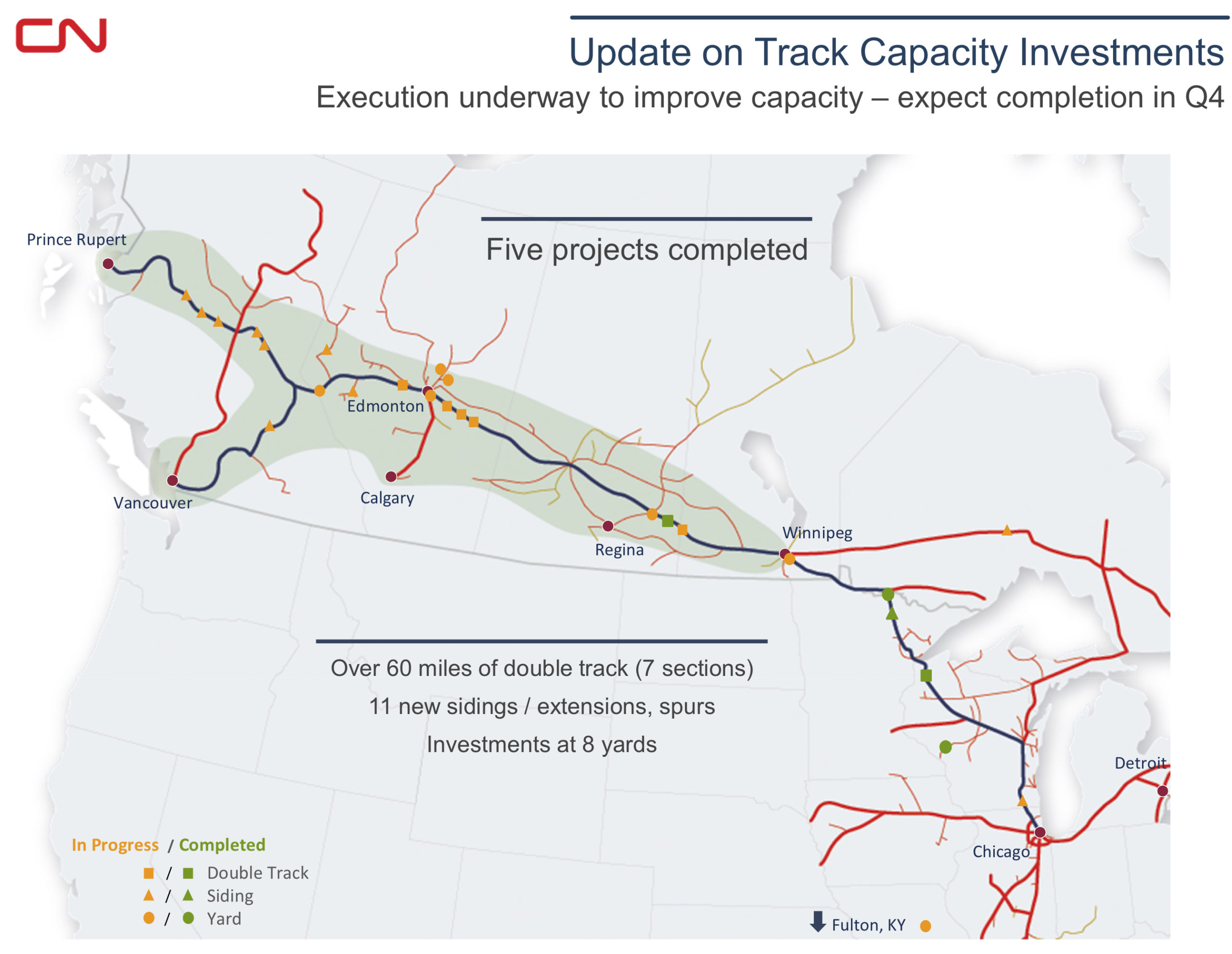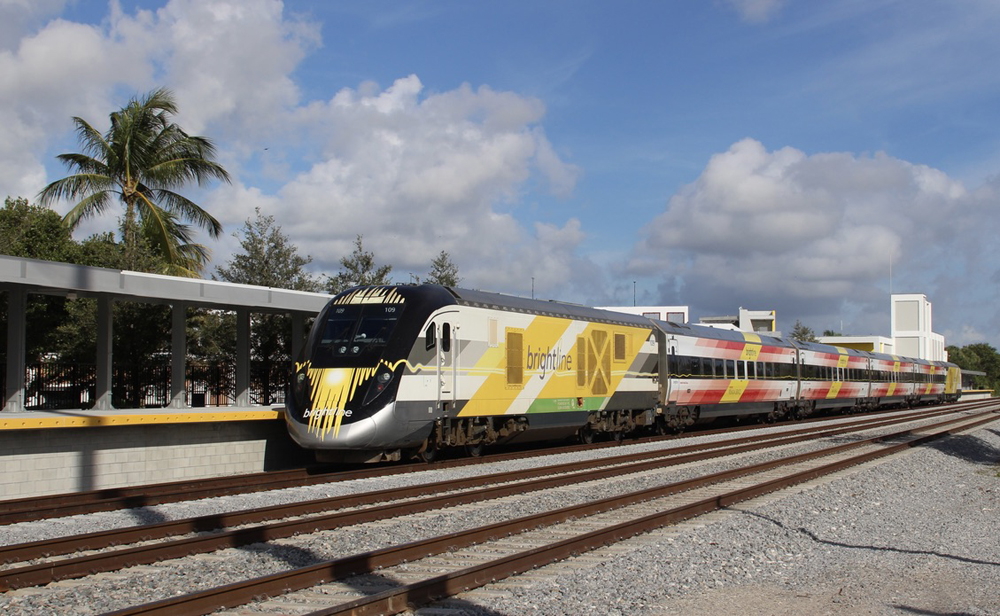Less than 100 miles of the 800-mile corridor is currently double iron, Chief Operating Officer Mike Cory says, not including the five sections of double-track that’s being added this year.
“Absolutely before I pass this earth I’m hoping to see the the majority of it double-track,” Cory, 56, told investors and analysts on CN’s July 24 earnings call.
Asked whether the double-tracking is a five- or 10-year plan, Cory responded: “It’s a forever plan. This is really in our breadbasket.”
The Edmonton-Winnipeg route is CN’s spine, carrying grain, potash, petrochemicals, energy-related commodities like frac sand and steel pipe, as well as intermodal traffic.
More double-track will make CN more resilient in the face of winter weather.
“It’s the toughest of weather conditions of any Class I railway,” Cory says.
The route has about 50 miles of double track between Winnipeg and Portage la Prairie, Manitoba, but efforts to continue double-tracking beyond that section stopped in the 1970s, Cory says.
CN likely will add another four or five sections of double-track to the line next summer as it anticipates continued strong traffic growth.
CN got into a capacity crunch last year when traffic came on much faster than expected and it was short of crews, locomotives, and track capacity. The railroad did not add track capacity on the line after traffic declined in 2016.
CN executives have said they won’t make that mistake again.
“We will not stop even when volume goes down,” Cory says.
“There’s not a specific timeline,” CEO Jean-Jacques Ruest says. “It’s more volume-related than anything else.”
CN has completed five track expansion projects so far this year as it ramps up capacity in Western Canada and on its route linking Winnipeg and Chicago.
The work, which will wrap up in late fall, includes more than 60 miles of double track in seven sections, 11 new or extended sidings, and investments at eight yards.














Canadian National finally woke up ,trains waiting at sidings and in yards to have a clear track big waste of money and time and I,m sure crews ran out of time in some cases! Now if Norforlk & Southern sees the light at the end of the tunnel and did the same thing with all its single track routes that would also be a win for the company .
With their recent excessive high profits according to their latest financial report I`m sure they can easily afford to double track all the way to Toronto from Winnipeg even though there more rugged land to excavate.. This will ensure that VIA`S Canadian can still continue to exist.
If I recall correctly CN was privatised in the 1970s, just about when as someone commented the double tracking project stopped. Just another case of taking over a public asset and bleeding it dry.
Double tracking isn’t as simple as grading and laying track. There are land use issues sometimes on either side of the existing track, bridges, and experienced crews to consider. Double tracking a bridge section usually means building a new single or double track bridge. That gets really expensive.
I think ripping out double track sections was short-sided despite not needing it to its full capacity back then.
Glad to see the growth and investment. Hunter Harrison was a single-track man. All his experience was on IC, CN — mostly straight-shot mains from point to point. That’s why he couldn’t get his arms around something as complex as CSX.
ALAN – If Canada is a tenth as bureaucratic as USA it takes years to build anything. That’s if everything goes right. All it takes is one NIMBY or one special interest and the smallest, least impacting project can be stopped for years at a time. I recall under a certain former Wisconsin governor who hated my home county (because almost none of us voted for him) some species of snake held up every development in the county. With no evidence that the snake species was endangered or even threatened.
I would hope that BNSF takes a hint and resumes the “double-tracking” of its Northern Transcontinental route west from Williston, North Dakota.
I don’t claim to know the first thing about business management, but I suspect the answer to Alan Follett’s “why not do it quickly?” is that there is only so much capital available at any one time to sink into the project. Going too fast would spread corporate resources too thin and jeopardize the whole company.
Well, slowly…but, if it’s worth doing slowly, why not do it quickly? CN has a catastrophic capacity problem, of which the ludicrous Canadian timing is only the most obvious symptom. Why shouldn’t the goal be double-tracking by, say, the end of the 2020 construction season?
Nice to see a railroad (besides BNSF) with enough guts to say to the analysts we’ll provide first class service FIRST, then the OR will drop naturally via increased REVENUES instead of slashed operations. Take note, CSX!
IC has more capacity now with single track TCS and well-spaced sidings than they ever did with double track one-way running.
Sure would be nice if they re-double tracked the former IC main line south of Chicago. That was ripped up in the 90s.
DAVID H. _ By the time the double-tracking is enough to make an impact, The Canadian will be long gone. The people of Canada know that even as recently as thirty years ago they had a great passenger train system, coast to coast Now all that’s left is next to nothing. If Canada can do without 95% of its formerly awesome passenger rail system it can do without the remaining 5% as well. What is left, one train for all of Maritime Canada and I don’t even know if it runs daily. VIA is a sick joke. Compare a 1980’s VIA timetable to now, you would throw up.
Totally different eras of course, but whenever I see the scale and quality of old PRR works I immediately think: “Man, these guys did NOT mess around”.
Steven Bauer,
I wondered the same thing. Usually, they cut resources down far enough to get a certain OR and leave it to the field personnel to some how make it all work, with predictable results.
“We will not stop even when volume goes down,” Cory says.
What a novel idea. Planning for the future. I bet the stockholders and EHH groupies, however, are slitting their wrists at the thought of actually spending money based on future needs.
Maybe double-tracking will help keep the Canadian on time.
Good to see that CN is again proud of being a railroad and wants to grow business instead of turning it away for the sake of meeting an arbitrary number set up by some big Ego.
Still a pity that already-existing double track was removed on the Edson and Blue River subdivisions in 2001. This is not part of the Edmonton – Winnipeg corridor that is currently being expanded, but the second main will nevertheless be required again at some point. Alas, lay it down (again) will come at a much greater cost than what was gained by removing it in the first place.
https://www.producer.com/2001/10/cn-rail-rips-out-line-on-double-track-near-jasper/
P.S. The Northern Ontario main line would also benefit from additional extended sidings too, btw. This line is giving CN a longer haul (to Toronto and Eastern Canada) than the former WC/IC to Chicago and Memphis. Just sayin’…